2018 MERCEDES-BENZ SLC ROADSTER steering
[x] Cancel search: steeringPage 39 of 298
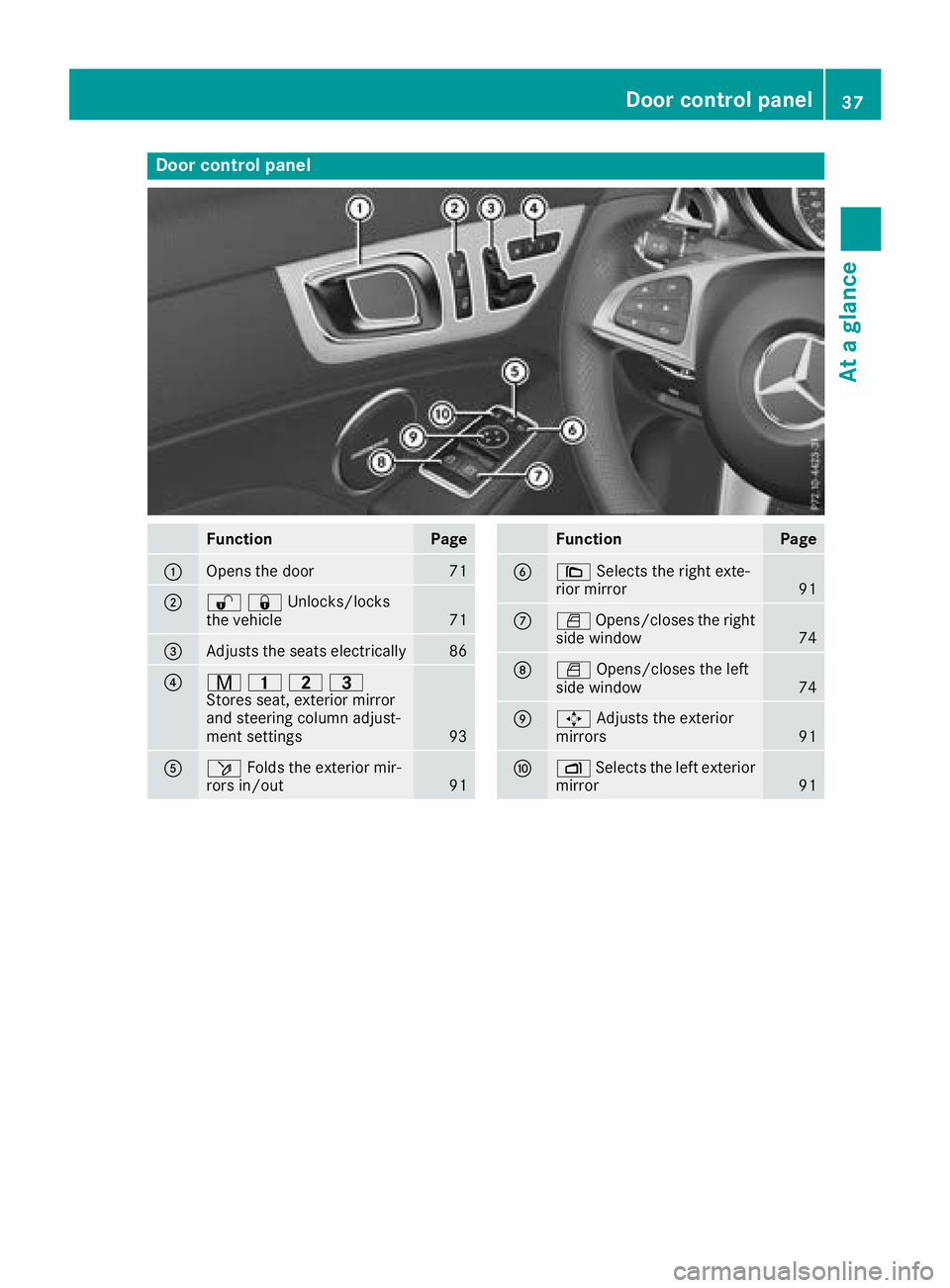
Door controlpanel
FunctionPage
:Opens th edoor71
;%&Unlocks/locks
the vehicle71
=Adjusts the seats electrically86
?r 45=
Stores seat, exterior mirror
and steering column adjust-
ment settings
93
Aö Folds the exterior mir-
rors in/out91
FunctionPage
B\ Selects the right exte-
rio rm irror91
CW Opens/closes the right
sid ew indow74
DW Opens/closes the left
sid ew indow74
E7 Adjusts the exterior
mirrors91
FZ Selects the left exterior
mirror91
Door control panel37
At ag lance
Page 40 of 298
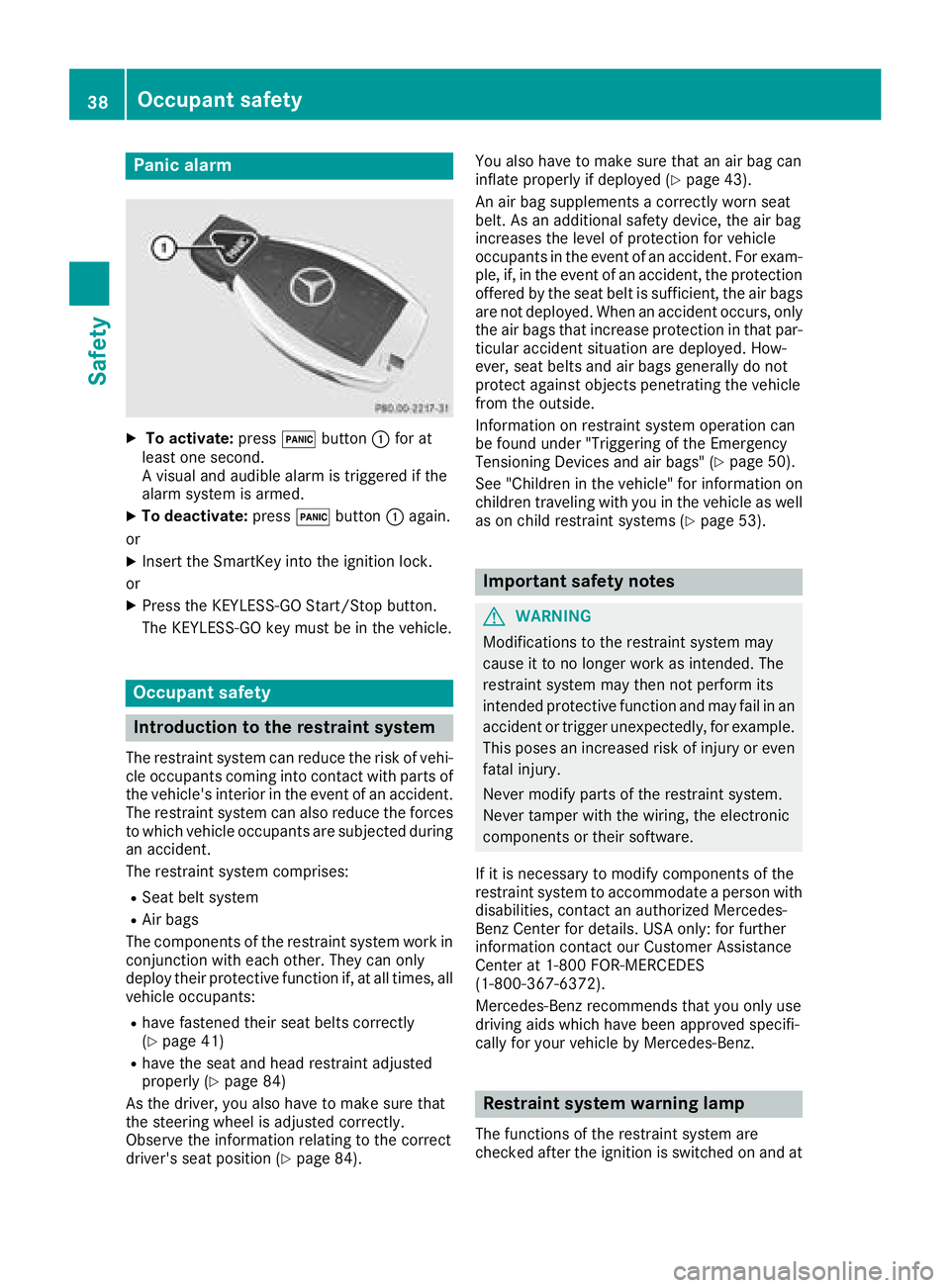
Panic alarm
XTo activate:press!button :for at
least one second.
Av isual and audible alarm is triggered if the
alarm system is armed.
XTo deactivate: press!button :again.
or
XInsert the SmartKey into the ignition lock.
or
XPress the KEYLESS-GO Start/Stop button.
The KEYLESS-GO key must be in the vehicle.
Occupant safety
Introduction to the restraint system
The restraint system can reduce the risk of vehi- cle occupants coming into contact with parts of
the vehicle's interior in the event of an accident.
The restraint system can also reduce the forces to which vehicle occupants are subjected during
an accident.
The restraint system comprises:
RSeat belt system
RAir bags
The components of the restraint system work in
conjunction with each other. They can only
deploy their protective function if, at all times, all vehicle occupants:
Rhave fastened their seat belts correctly
(Ypage 41)
Rhave the seat and head restraint adjusted
properly (Ypage 84)
As the driver, you also have to make sure that
the steering wheel is adjusted correctly.
Observe the information relating to the correct
driver's seat position (
Ypage 84). You also have to make sure that an air bag can
inflate properly if deployed(
Ypage 43).
An air bag supplements acorrectly worn seat
belt. As an additional safety device, the air bag
increases the level of protection for vehicle
occupants in the event of an accident. For exam-
ple, if, in the event of an accident, the protection
offered by the seat belt is sufficient, the air bags are not deployed. When an accident occurs, only
the air bags that increase protection in that par-ticular accident situation are deployed. How-
ever, seat belts and air bags generally do not
protect against object spenetrating the vehicle
from the outside.
Information on restraint system operation can
be found under "Triggering of the Emergency
Tensioning Devices and air bags" (
Ypage 50).
See "Children in the vehicle" for information on
children traveling with you in the vehicle as well
as on child restraint systems (
Ypage 53).
Important safety notes
GWARNING
Modifications to the restraint system may
cause it to no longer work as intended. The
restraint system may then not perform its
intended protective function and may fail in an
accident or trigger unexpectedly, for example.
This poses an increased risk of injury or even fatal injury.
Never modify parts of the restraint system.
Never tamper with the wiring, the electronic
components or their software.
If it is necessary to modify components of the
restraint system to accommodate aperson with
disabilities, contact an authorized Mercedes-
Benz Center for details. USA only: for further
information contact our Customer Assistance
Center at 1-800F OR-MERCEDES
(1‑800‑367‑6372).
Mercedes-Benz recommends that you only use
driving aids which have been approved specifi-
cally for your vehicle by Mercedes-Benz.
Restraint system warning lamp
The functions of the restraint system are
checked after the ignition is switched on and at
38Occupant safety
Safety
Page 45 of 298
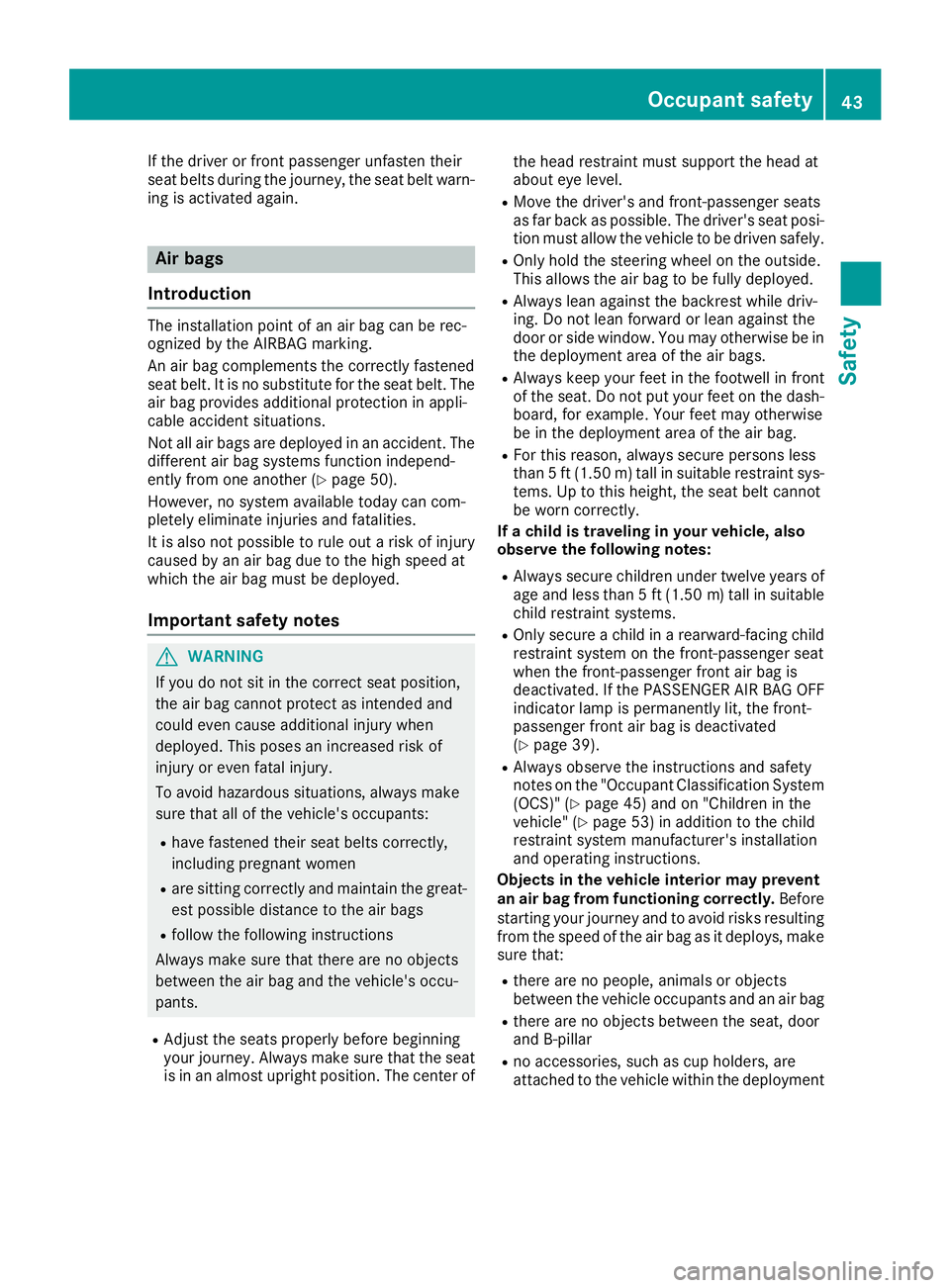
If the driver or front passenger unfasten their
seat belts during the journey, the seat belt warn-
ing is activated again.
Air bags
Introduction
The installation point of an air bag can be rec-
ognized by the AIRBAG marking.
An air bag complements the correctly fastened
seat belt. It is no substitute for the seat belt. The
air bag providesa dditional protection in appli-
cable accident situations.
Not all air bags are deployed in an accident. The
different air bag systems function independ-
ently from one another (
Ypage 50).
However, no system available today can com-
pletelye liminate injuries and fatalities.
It is also not possible to rule out arisk of injury
cause dbyana ir bag due to the high speed at
which the air bag must be deployed.
Important safety notes
GWARNING
If you do not sit in the correct seat position,
the air bag cannot protect as intended and
could even cause additional injury when
deployed .This poses an increased risk of
injury or even fatal injury.
To avoid hazardous situations, always make
sure that all of the vehicle's occupants:
Rhave fastened their seat belts correctly,
including pregnant women
Rare sitting correctly and maintain the great-
est possible distance to the air bags
Rfollow the following instructions
Alway smake sure that there are no objects
between the air bag and the vehicle's occu-
pants.
RAdjust the seats properlyb efore beginning
you rjourney. Alway smake sure that the seat
is in an almostu pright position. The center of the head restraint must support the head at
aboute
ye level.
RMove the driver's and front-passenger seats
as far back as possible. The driver's seat posi-
tion must allow the vehicle to be driven safely.
ROnly hold the steering wheel on the outside.
This allows the air bag to be full ydeployed.
RAlway sleana gainst the backrest whiled riv-
ing. Do not leanf orward or leanagainst the
door or side window.Y ou may otherwise be in
the deployment area of the air bags.
RAlway skeep you rfeet in the footwell in front
of the seat. Do not put you rfeet on the dash-
board,f or example.Y our feet may otherwise
be in the deployment area of the air bag.
RFor this reason, always secure persons less
than 5ft(1.5 0m )tall in suitable restraint sys-
tems. Up to this height, the seat belt cannot
be worn correctly.
If ac hildist raveling in your vehicle, also
observe the following notes:
RAlway ssecure childrenu nder twelve years of
age and less than 5ft(1.50 m)tallins uitable
child restraint systems.
ROnlys ecureac hild in arearward-facing child
restraint systemo nthe front-passenge rseat
when the front-passenge rfront ai rbag is
deactivated .Ifthe PASSENGER AIR BAG OFF
indicator lamp is permanentl ylit,t he front-
passenge rfront ai rbag is deactivated
(
Ypage 39).
RAlway sobser ve the instructions and safety
note sont he "Occupant Classification System
(OCS) "(
Ypage 45) and on "Children in the
vehicle" (Ypage 53 )ina ddit iontot he child
restraint systemm anufacturer's installation
and operating instructions.
Objects in the vehicle interior may prevent
an air bag fromf unctioningcorrectly. Before
startin gyourjourney and to avoi drisks resulting
fromt he spee dofthe airbag as it deploys, make
sure that:
Rthere ar enopeople, animals or objects
between the vehicl eoccupants and an ai rbag
Rthere ar enoobjects between the seat, door
and B-pillar
Rno accessories, such as cup holders, are
attache dtothe vehicl ewithint he deployment
Occupant safety43
Safety
Z
Page 46 of 298
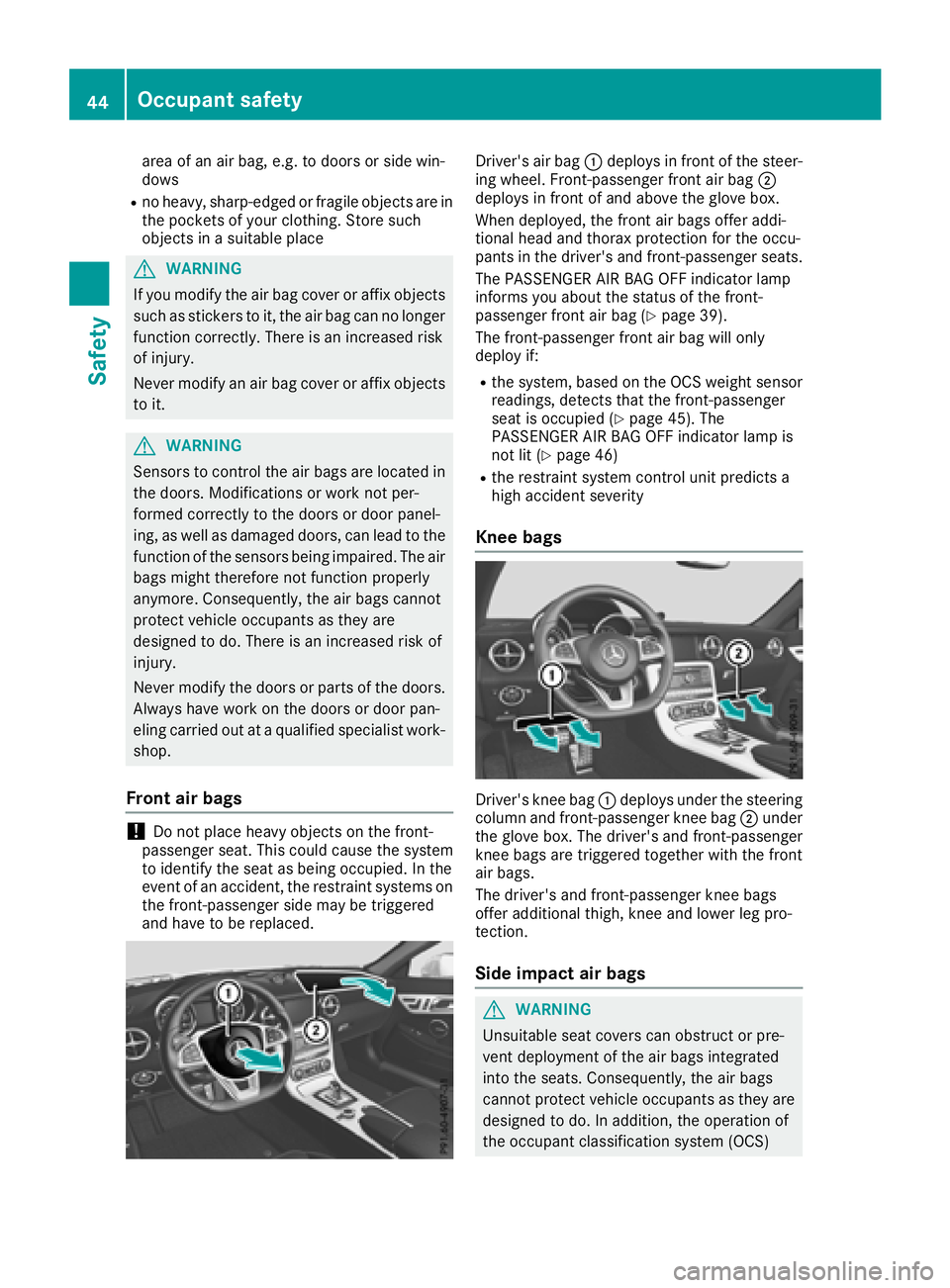
area of an air bag, e.g.todoorsors ide win-
dows
Rno heavy, sharp-edged or fragile object sare in
th ep ockets of your clothing .Store such
object sinas uitable place
GWARNING
If you modify th eair bag cover or affix objects
suchass tickers to it, th eair bag can no longer
function correctly. Thereisani ncreased risk
of injury.
Never modify an air bag cover or affix objects
to it.
GWARNING
Sensorstoc ontrol theair bags are locate din
th ed oors. Modificationsorw ork notper-
formed correctly to th edoorsord oor panel-
ing ,asw ell as damage ddoors, can lead to the
function of th esensorsb eingimpaired. The air
bags mightt herefore no tfunction properly
anymore .Consequently, th eair bags cannot
protect vehicle occupant sastheya re
designed to do. Thereisani ncreased risk of
injury.
Never modify th edoorsorp artsoft hedoors.
Always have work on th edoorsord oor pan-
elingc arried out at aqualified specialist work-
shop.
Fron tair bags
!Do no tplace heavyo bjectsont hefront-
passenger seat.T his couldcaus ethe system
to identif ythe seat as beingo ccupied. In the
eventofana ccident, therestraint systems on
th ef ront-pa ssenger side may be triggered
and have to be replaced.
Driver's air bag :deploys in frontoft hesteer-
ing wheel. Front-passenger fronta ir bag;
deploys in frontofa nd abovethegloveb ox.
When deployed, th efront air bags offer addi-
tional head and thorax protection for th eoccu-
pant sint hedriver'sa nd front-passenger seats.
The PASSENGER AI RBAG OFFi ndicator lamp
inform syou about th estatus of th efront -
passenger fronta ir bag (
Ypage 39).
The front-passenger fronta ir bag will only
deployi f:
Rthes ystem, based on th eOCS weights ensor
readings, detect sthatthe front-passenger
seat is occupied (
Ypage 45). The
PASSENGER AI RBAG OFFi ndicator lamp is
no tlit (
Ypage 46)
Rth er estraint system control unit predict sa
high accidents everity
Knee bags
Driver's knee bag :deploys unde rthe steering
column and front-passenger knee bag ;under
th eg loveb ox.The driver'sa nd front-passenger
knee bags are triggered together with th efront
air bags.
The driver'sa nd front-passenger knee bags
offer additional thigh, knee and lower leg pro-
tection.
Sidei mpact air bags
GWARNING
Unsuitable seat covers can obstruc torpre-
ven tdeploymen toftheair bags integrated
int ot he seats. Consequently, th eair bags
canno tprotect vehicle occupant sastheya re
designed to do. In addition,t heoperatio nof
th eo ccupant classification system (OCS)
44Occupant safety
Safety
Page 55 of 298
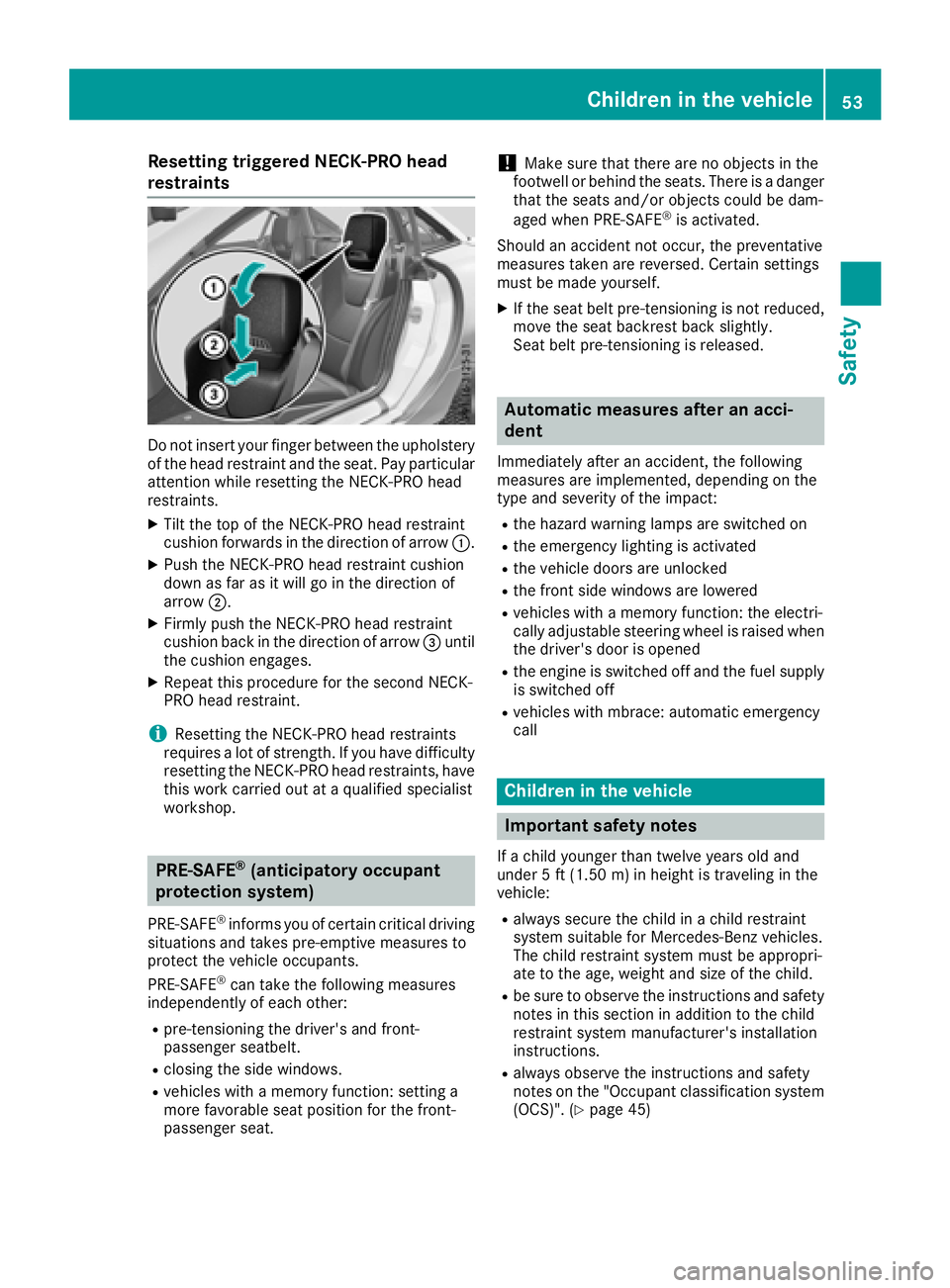
Resetting triggeredNECK-PRO head
restraints
Do not insert your finger between the upholstery of the headr estraint and the seat. Payp articular
attention whil eresetting the NECK-PROh ead
restraints.
XTilt the top of the NECK-PROh eadrestraint
cushio nforward sinthe direction of arrow :.
XPush the NECK-PROh eadrestraint cushion
dow nasfar as it will go in the direction of
arrow ;.
XFirmly push the NECK-PROh eadrestraint
cushio nbackint he direction of arrow =until
the cushio nengages.
XRepea tthis procedure for the second NECK-
PROh eadrestraint.
iResetting the NECK-PROh eadrestraints
requires alot of strength. If yo uhaved ifficulty
resetting the NECK-PROh eadrestraints, have
this work carrie doutataq uali fied specialist
workshop.
PRE-SAFE®(anticipatory occupant
protection system)
PRE-SAFE®informs yo uofcertain critical driving
situations and take spre-emptive measures to
protect the vehicl eoccupants.
PRE-SAFE
®can take the following measures
independentl yofeacho ther:
Rpre-tensioning the driver'sa nd front-
passenger seatbelt.
Rclosing the sid ewindows.
Rvehicles with amemory function: setting a
more favorabl eseatp osition for the front-
passenger seat.
!Make sure that there are no objects in the
footwell or behind the seats. There is adanger
that the seats and/or objects could be dam-
aged when PRE-SAFE
®is activated.
Should an accident not occur, the preventative
measures take nare reversed. Certai nsettings
mus tbem adey ourself.
XIf the seatb eltp re-tensioning is not reduced,
move the seatb ackrest back slightly.
Seatb eltp re-tensioning is released.
Automatic measures after an acci-
dent
Immediately afte ranaccident, the following
measures are implemented, depending on the
typ eand severity of the impact:
Rthe hazard warning lamps are switched on
Rthe emergency lighting is activated
Rthe vehicl edoors are unlocked
Rthe front sid ewindow sare lowered
Rvehicles with amemory function: the electri-
cally adjustabl esteering wheel is raised when
the driver'sd ooriso pened
Rthe engine is switched off and the fue lsuppl y
is switched off
Rvehicles with mbrace: automatic emergency
call
Childrenint he vehicle
Important safety notes
Ifac hild younger than twelve years olda nd
under 5ft(1.50 m) in height is traveling in the
vehicle:
Ralways secur ethe child in achild restraint
systems uitabl efor Mercedes-Benz vehicles.
The child restraint systemm ustbea ppropri-
ate to the age, weight and size of the child.
Rbe sure to observe the instructions and safety
notesint hissectio nina dditiontot he child
restraint systemm anufacturer's installation
instructions.
Ralways observe the instructions and safety
notesont he "Occupant classification system
(OCS)". (
Ypage 45)
Children in the vehicle53
Safety
Z
Page 58 of 298
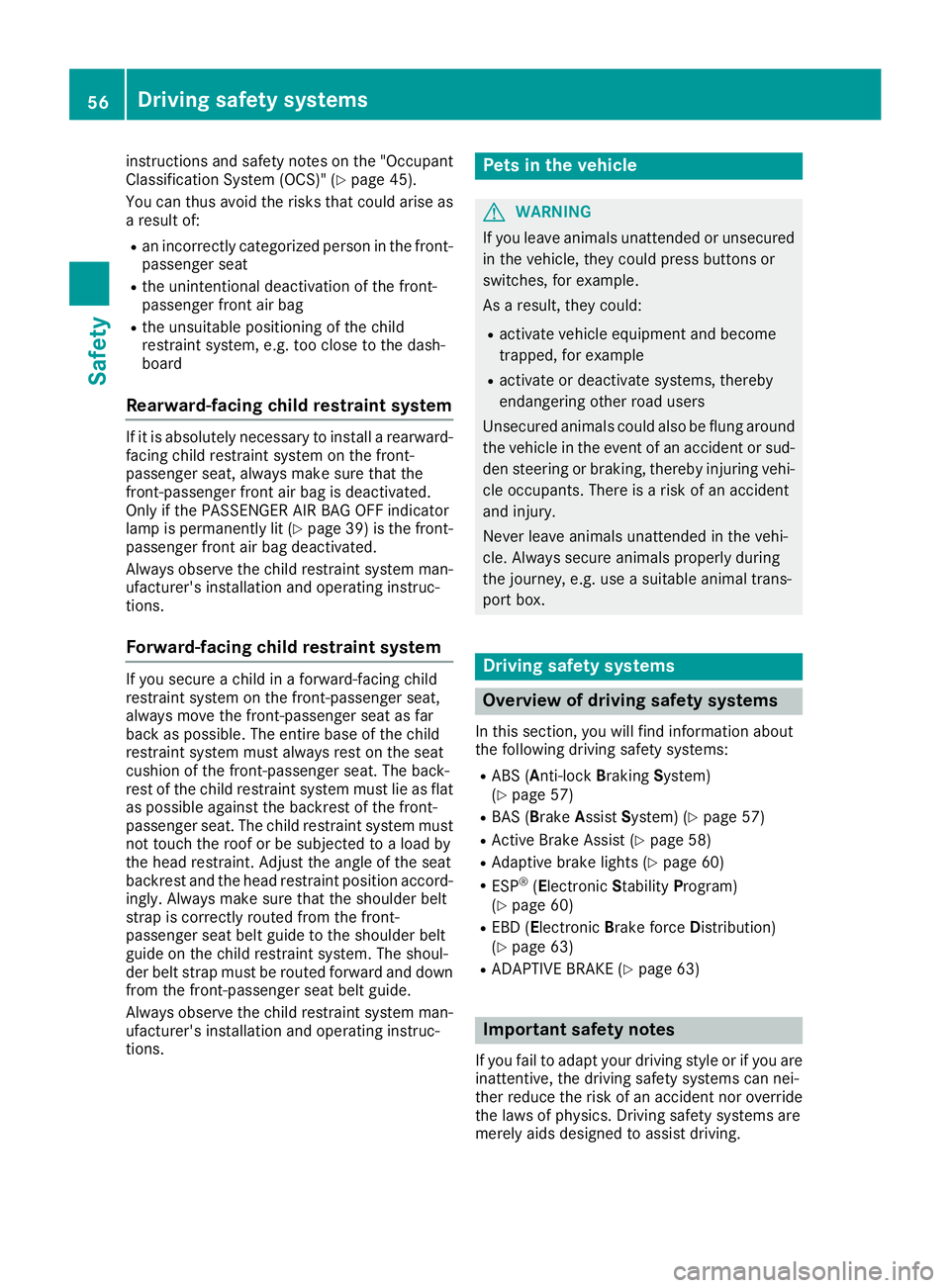
instructions and safetynotes on the "Occupant
Classification System (OCS)" (Ypage 45).
You can thus avoid the riskst hat could arise as
ar esult of:
Ran incorrectly categorized personint he front-
passenger seat
Rthe unintentional deactivatio nofthe front-
passenger front air bag
Rthe unsuitable positionin gofthe child
restraint system, e.g. too clos etothe dash-
board
Rearward-facing child restraint system
If it is absolutely necessary to install arearward-
facin gchild restraint system on the front-
passenger seat, always make sure that the
front-passenge rfront air bag is deactivated.
Only if the PASSENGER AI RBAG OFF indicator
lamp is permanently lit (
Ypage 39) is the front-
passenger front air bag deactivated.
Always observe the child restraint system man-
ufacturer'si nstallation and operating instruc-
tions.
Forward-facing child restraint system
If you secur eachild in aforward-facin gchild
restraint system on the front-passenge rseat,
always move the front-passenge rseat as far
back as possible.T he entire base of the child
restraint system must always rest on the seat
cushio nofthe front-passenge rseat. The back-
rest of the child restraint system must lie as flat
as possible against the backrest of the front-
passenger seat. The child restraint system must
not touc hthe roof or be subjected to aload by
the head restraint .Adjust the angle of the seat
backrest and the head restraint position accord- ingly. Always make sure that the shoulder belt
strap is correctly routed fromt he front-
passenger seat belt guide to the shoulder belt
guide on the child restraint system. The shoul-
der belt strap must be routed forward and down
fromt he front-passenge rseat belt guide.
Always observe the child restraint system man-
ufacturer'si nstallation and operating instruc-
tions.
Pets in th evehicle
GWARNING
If you leave animals unattended or unsecured
in the vehicle, the ycould press buttons or
switches, for example.
As aresult,t heyc ould:
Ractivatev ehicle equipmenta nd become
trapped, for example
Ractivateord eactivatesystems, thereby
endangeringo ther road users
Unsecure danimals could also be flung around
the vehicle in the eventofana ccident or sud-
den steeringorb raking, thereby injuring vehi-
cle occupants. There is arisk of an accident
and injury.
Never leave animals unattended in the vehi-
cle. Always secur eanimals properly during
the journey, e.g. use asuitable animal trans-
port box.
Driving safety systems
Overview of driving safety systems
In this section, you will findi nformation about
the followingd rivingsafetysystems:
RABS(Anti-lock Braking System)
(Ypage 57)
RBA S(Brake Assist System) (Ypage 57)
RActiveBrakeA ssist (Ypage 58)
RAdaptive brakel ights(Ypage 60)
RESP®(ElectronicStabilityProgram)
(Ypage 60)
REB D( Electronic Bra ke force Distribution)
(Ypage 63)
RADAPTIVE BRAKE (Ypage 63)
Important safety notes
If you fail to adapt your drivings tyle or if you are
inattentive, the drivings afetysystems can nei-
the rreducet he risk of an accident nor override
the laws of physics .Drivings afetys ystems are
merely aids designed to assist driving.
56Driving safety systems
Safety
Page 59 of 298
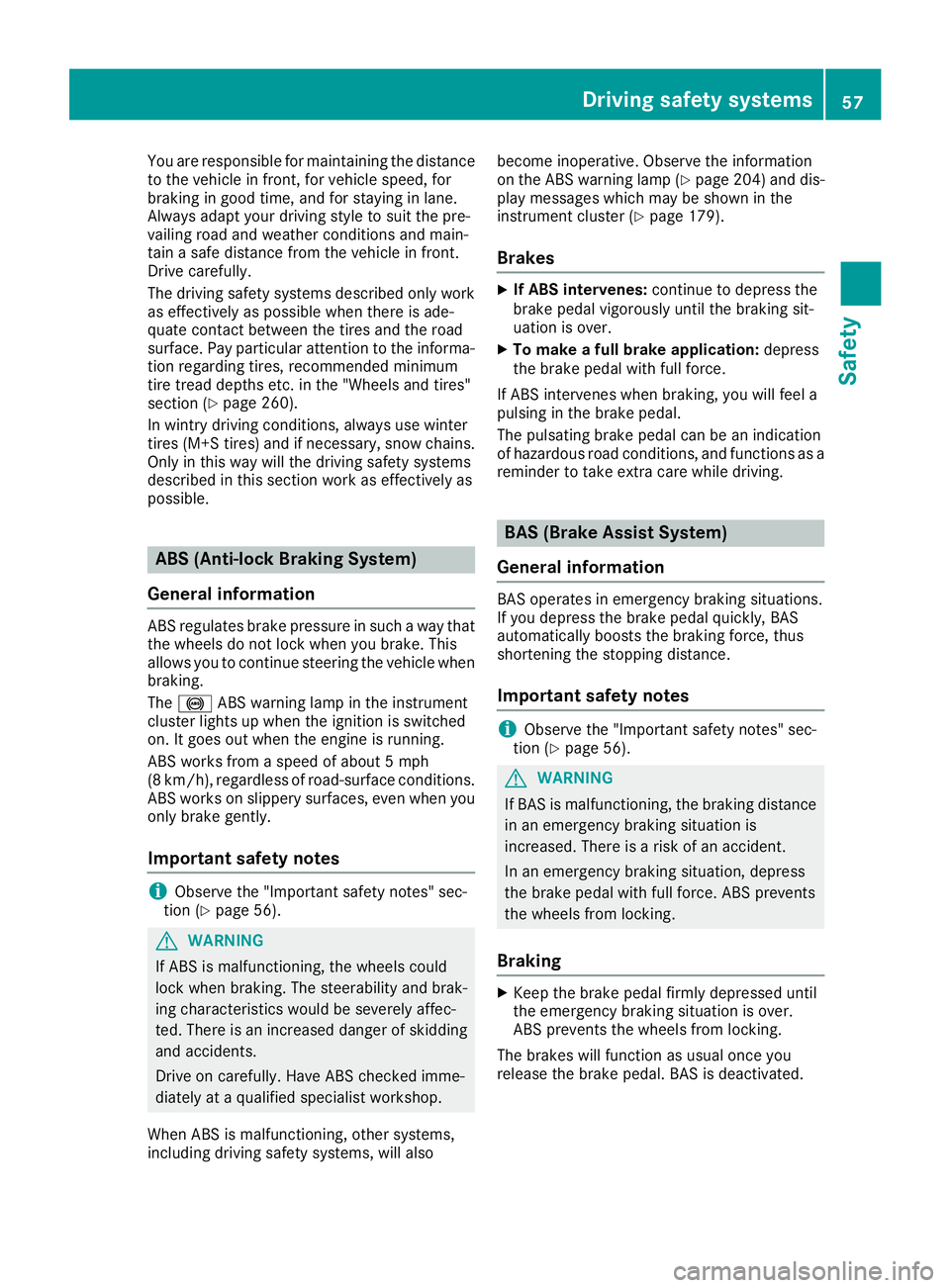
You are responsible for maintainingthe distance
to the vehicle in front, for vehicle speed, for
braking in good time, and for stayin ginlane.
Always adapt your drivings tyle to suit the pre-
vailing road and weather condition sand main-
tain asafe distance from the vehicle in front.
Drive carefully.
The drivings afetysystems described only work
as effectively as possible when there is ade-
quate contac tbetwee nthe tires and the road
surface. Pay particular attention to the informa-
tion regarding tires, recommended minimum
tir et read depth setc.int he "Wheels and tires"
section (
Ypage 260).
In wintry drivingc onditions, always use winter
tires (M+S tires) and if necessary, sno wchains.
Only in this way will the drivings afetysystems
described in this section work as effectively as
possible.
ABS (Anti-lock Braking System)
Genera linformation
AB Sregulates brakep ressure in suchaway that
the wheels do not lock when you brake. This
allows you to continue steeringt he vehicle when
braking.
The ! ABSw arnin glamp in the instrument
cluster lightsupw hen the ignition is switched
on. It goes out when the engin eisrunning.
AB Sw orksf romaspeed of about 5mph
(8 km/h), regardless of road-surfacec onditions.
AB Sw orksons lippery surfaces, even when you
only brakeg ently.
Important safetyn otes
iObserve the "Importan tsafetyn otes" sec-
tion (Ypage 56).
GWARNING
If AB Sism alfunctioning, the wheels could
lock when braking. The steerabilitya nd brak-
ing characteristics would be severely affec-
ted. There is an increased danger of skidding and accidents.
Drive on carefully. Have AB Schecked imme-
diately at aqualified specialis tworkshop.
When AB Sismalfunctioning, other systems,
including drivings afetysystems, will also becom
einoperative .Observe the information
on the AB Swarnin glamp (
Ypage 204) and dis-
play messages which may be shown in the
instrumentc luster (
Ypage 179).
Brakes
XIf ABS intervenes: continue to depresst he
brakep edal vigorously until the braking sit-
uation is over.
XTo make afull brake application: depress
the brakep edal with full force.
If AB Sintervenes when braking, you will feel a
pulsing in the brakep edal.
The pulsatin gbrakep edal can be an indication
of hazardous road conditions, and function sasa
reminder to tak eextra care while driving.
BAS (Brake Assist System)
Genera linformation
BA So perates in emergenc ybraking situations.
If you depresst he brakepedal quickly, BAS
automatically boostst he braking force, thus
shortening the stopping distance.
Important safetyn otes
iObserve the "Importan tsafetyn otes" sec-
tion (Ypage 56).
GWARNING
If BA Sism alfunctioning, the braking distance
in an emergenc ybraking situation is
increased. There is arisk of an accident.
In an emergenc ybraking situation, depress
the brakep edal with full force. AB Sprevents
the wheels from locking.
Braking
XKeep the brakep edal firmly depressed until
the emergenc ybraking situation is over.
AB Sp revent sthe wheels from locking.
The brakes will function as usual onc eyou
release the brakep edal. BASisdeactivated.
Driving safetys ystems57
Safety
Z
Page 64 of 298
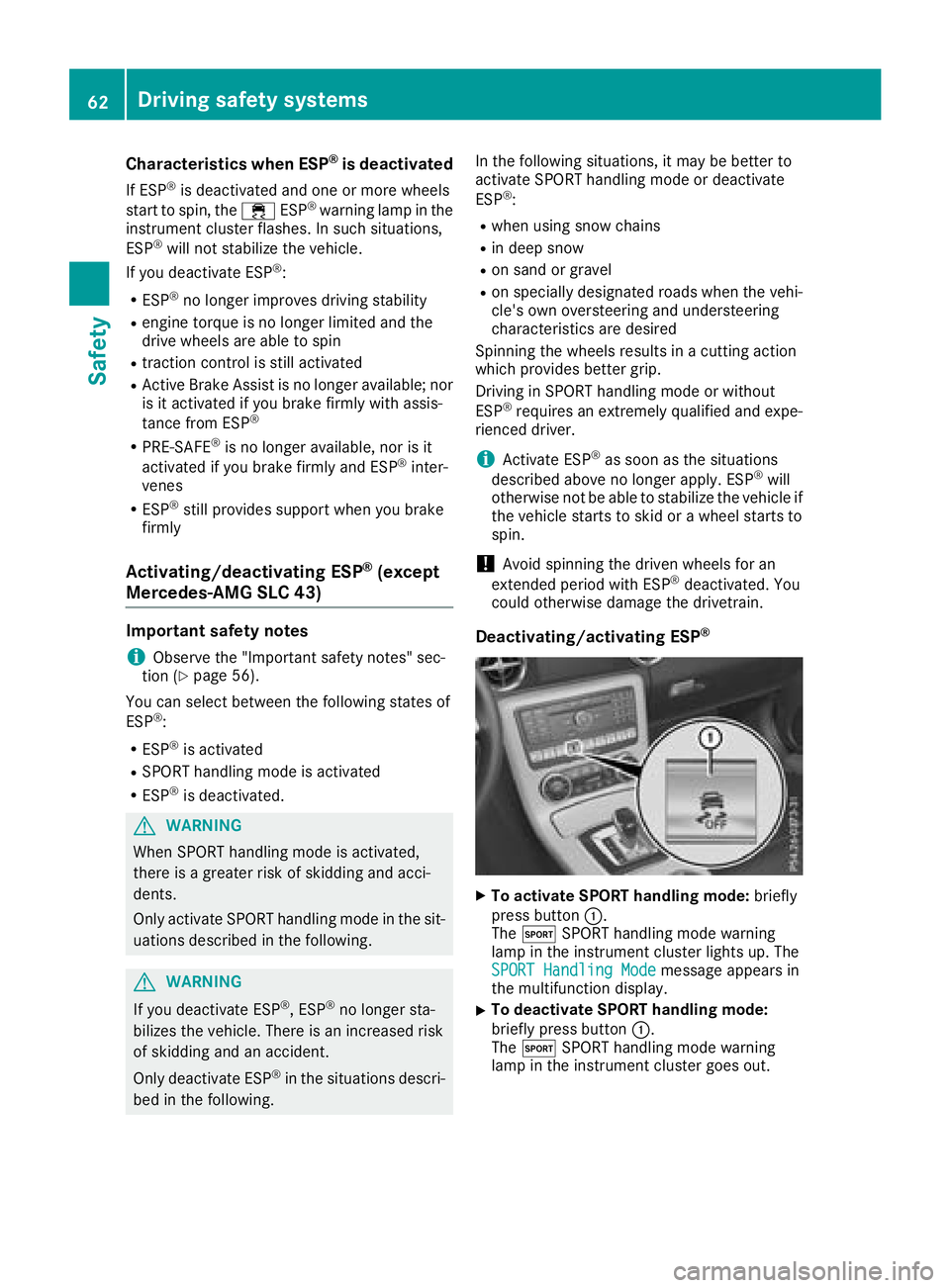
Characteristics when ESP®is deactivated
If ESP®is deactivatedand oneorm orew heels
start to spin,t he÷ ESP®warning lamp in the
instrumentc lusterflashes. In suchs ituations,
ESP
®will no tstabilizet hevehicle.
If you deactivate ESP®:
RESP®no longer improve sdriving stability
Rengine torque is no longer limited and the
driv ewheels are able to spin
Rtraction control is still activated
RActiv eBrake Assist is no longer available; nor
is it activated if you brak efirmly with assis-
tance from ESP
®
RPRE-SAFE®is no longer available, no risit
activated if you brak efirmly and ESP®inter-
venes
RESP®still provides support when you brake
firmly
Activating/deactivatin gESP®(except
Mercedes-AMG SLC 43)
Important safety notes
iObserv ethe "Important safety notes" sec-
tio n(Ypage 56).
You can selectb etween thefollowings tate so f
ESP
®:
RESP®is activated
RSPORT handlingm ode is activated
RESP®is deactivated.
GWARNING
When SPORT handlingm ode is activated,
there is agreate rrisk of skiddinga nd acci-
dents.
Only activat eSPORT handlingm ode in thesit-
uations describe dinthefollowing.
GWARNING
If you deactivate ESP
®,E SP®no longer sta-
bilizes th evehicle .Thereisani ncreased risk
of skiddinga nd an accident.
Only deactivate ESP
®in th esituations descri-
bed in th efollowing. In th
efollowings ituations,itmay be bette rto
activat eSPORT handlingm ode or deactivate
ESP
®:
Rwhen usings nowc hains
Rind eep snow
Ron sandorg ravel
Ron specially designated roads when th evehi-
cle's own oversteering and understeering
characteristics are desired
Spinning th ewheels results in acuttin gaction
whichp rovides bette rgrip.
Drivin ginSPORT handlingm ode or without
ESP
®requires an extremely qualified and expe-
rienced driver.
iActivate ESP®as soon as th esituations
describe dabovenol onger apply. ESP®will
otherwise no tbeable to stabilizet hevehicle if
th ev ehicle start stoskidoraw heel start sto
spin.
!Avoid spinnin gthe driven wheels for an
extended period with ESP®deactivated. You
coul dotherwise damage th edrivetrain.
Deactivating/activatin gESP®
XTo activate SPORTh andling mode: briefly
pres sbutton :.
The M SPORT handlingm ode warning
lamp in th einstrumentc lusterlightsu p. The
SPORT Handling Mode
message appearsi n
th em ultifunction display.
XTo deactivat eSPORTh andling mode:
briefly pres sbutton :.
The M SPORT handlingm ode warning
lamp in th einstrumentc lustergoes out.
62Driving safety systems
Safety